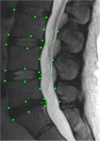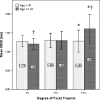The relationship between degree of facet tropism and amount of dynamic disc bulge in lumbar spine of patients symptomatic for low back pain
- PMID: 20734211
- PMCID: PMC3036031
- DOI: 10.1007/s00586-010-1558-8
The relationship between degree of facet tropism and amount of dynamic disc bulge in lumbar spine of patients symptomatic for low back pain
Abstract
Facet tropism has been investigated as a predisposing factor for degenerative changes in the lumbar spine; however, no prior study has evaluated the relationship between disc bulge and facet tropism. In this study, we used kinetic magnetic resonance imaging (kMRI) to investigate the association between degree of facet tropism and amount of disc bulge in the lumbar spine in relation to age. kMRIs in the flexion, neutral, and extension positions were performed on 410 consecutive patients with low back pain. T2-weighted midsagittal and axial mid-disc cuts were analyzed to measure disc bulge and facet angle. Facet asymmetry was calculated and classified as: no facet tropism, <6°; mild facet tropism, 6-11°; or severe facet tropism, ≥11°. Maximal static bulge (MSB), maximal dynamic bulge (MDB), and age in the facet tropism groups were compared by age subpopulations and MDB categories, defined by the positions between which the largest change in disc bulge occurs. We found the severe facet tropism group to be associated with a nearly significant increase in MSB and MDB over the no facet tropism group in the older subpopulation at the L4-L5 level only, and a larger MDB in the L4-L5 MDB category [E-N], where the greatest change in disc bulge occurs between neutral and extension positions (p = 0.013). Our findings suggest that severe facet tropism is associated with increased disc bulge at L4-L5 in only a subset of older age patients, but may in large part be due to biomechanical factors that define the [E-N] category.
Figures






Similar articles
-
The relationship between disc degeneration, facet joint osteoarthritis, and stability of the degenerative lumbar spine.J Spinal Disord. 2000 Oct;13(5):444-50. doi: 10.1097/00002517-200010000-00013. J Spinal Disord. 2000. PMID: 11052356
-
Factors affecting dynamic foraminal stenosis in the lumbar spine.Spine J. 2013 Sep;13(9):1080-7. doi: 10.1016/j.spinee.2013.03.041. Epub 2013 May 10. Spine J. 2013. PMID: 23669126
-
Lumbar segmental mobility according to the grade of the disc, the facet joint, the muscle, and the ligament pathology by using kinetic magnetic resonance imaging.Spine (Phila Pa 1976). 2009 Nov 1;34(23):2537-44. doi: 10.1097/BRS.0b013e3181b353ea. Spine (Phila Pa 1976). 2009. PMID: 19841613
-
Lumbar Facet Tropism: A Comprehensive Review.World Neurosurg. 2017 Jun;102:91-96. doi: 10.1016/j.wneu.2017.02.114. Epub 2017 Mar 6. World Neurosurg. 2017. PMID: 28279769 Review.
-
Facet Tropism in Lumbar Spine and Cervical Spine: A Systematic Review and Meta-Analysis.World Neurosurg. 2021 Mar;147:47-65. doi: 10.1016/j.wneu.2020.11.171. Epub 2020 Dec 9. World Neurosurg. 2021. PMID: 33309642
Cited by
-
Evaluation of foraminal cross-sectional area in lumbar spondylolisthesis using kinematic MRI.Eur J Orthop Surg Traumatol. 2019 Jan;29(1):17-23. doi: 10.1007/s00590-018-2276-x. Epub 2018 Jul 27. Eur J Orthop Surg Traumatol. 2019. PMID: 30054742
-
Is there an anatomic basis for the different behavior of Lenke types 1AR and 1AL in idiopathic scoliosis? A study on facet joint tropism influence.Spine Deform. 2024 Jan;12(1):159-164. doi: 10.1007/s43390-023-00758-y. Epub 2023 Aug 22. Spine Deform. 2024. PMID: 37606796
-
The Prevalence of Facet Tropism and Its Correlation with Low Back Pain in Selected Community-Based Populations.Clin Orthop Surg. 2019 Jun;11(2):176-182. doi: 10.4055/cios.2019.11.2.176. Epub 2019 May 9. Clin Orthop Surg. 2019. PMID: 31156769 Free PMC article.
-
Is lumbar facet joint tropism developmental or secondary to degeneration? An international, large-scale multicenter study by the AOSpine Asia Pacific Research Collaboration Consortium.Scoliosis Spinal Disord. 2016 Feb 9;11:9. doi: 10.1186/s13013-016-0062-2. eCollection 2016. Scoliosis Spinal Disord. 2016. PMID: 27252985 Free PMC article.
-
Dynamic MRI in the evaluation of the spine: state of the art.Acta Biomed. 2018 Jan 19;89(1-S):89-101. doi: 10.23750/abm.v89i1-S.7012. Acta Biomed. 2018. PMID: 29350639 Free PMC article. Review.
References
-
- Farfan H, Sullivan J. The relation of facet orientation to intervertebral disc failure. Can J Surg. 1967;10:179–185. - PubMed
-
- Boden S, Riew K, Yamaguchi K, Branch TP, Schellinger D, Wiesel SW. Orientation of the lumbar facet joints: association with degenerative disc disease. J Bone Jt Surg Am. 1996;78:403–411. - PubMed
MeSH terms
LinkOut - more resources
Full Text Sources
Medical
Research Materials

